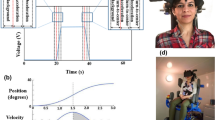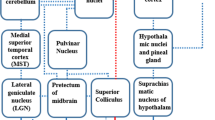Abstract
This paper addresses the question of whether visual stimuli of different colors can evoke a measurable vestibular response. A recently developed technique of measuring the vestibular response, called electrovestibulography (EVestG), was used in this study to assess the responsiveness of the efferent vestibular system. Visual stimuli of different colors (blue, green and red lights) along with white and black background were displayed to the participants through a virtual reality (VR) headset. Initially, the effect of each color was investigated; for each color, the corresponding red, green, or blue (RGB) value was set to 255 and the two others set to zero. Additionally, for the blue light, the impact of the intensity under well-lit (photopic) and low (close to mesopic vision range) intensity levels was separately examined. The results of this study indicate that not only does the vestibular system respond to light of different colors, but it also shows a sensitivity to the intensity of blue light. For blue light, the vestibular response changed in proportion to the intensity level, showing larger responses at higher intensities.





Similar content being viewed by others
Notes
1 lx =one lumen per square meter.
References
Longstaff, A. (2005). Instant notes in neuroscience (BIOS instant notes) (2nd ed.). Abingdon: Taylor & Francis.
Patestas, M. A., & Gartner, L. P. (2006). A textbook of neuroanatomy. Malden, MA: Blackwell Science Ltd.
Cullen, K. E. (2012). The vestibular system: Multimodal integration and encoding of self-motion for motor control. Trends in Neurosciences, 35, 185–196. https://doi.org/10.1016/j.tins.2011.12.001.
Azzena, G. B., Mameli, O., & Tolu, E. (1980). Distribution of visual input to the vestibular nuclei. Archives italiennes de biologie, 118(2), 196–204.
Kleinschmidt, A. (2002). Neural correlates of visual-motion perception as object- or self-motion. Neuroimage, 16, 873–882. https://doi.org/10.1006/nimg.2002.1181.
Walker, M. (1991). The power of color. New York: Avery Publishing Group.
Gurvich, C., Maller, J. J., Lithgow, B., et al. (2013). Vestibular insights into cognition and psychiatry. Brain Research, 1537, 244–259. https://doi.org/10.1016/j.brainres.2013.08.058.
Balaban, C. D., Jacob, R. G., & Furman, J. M. (2011). Neurologic bases for comorbidity of balance disorders, anxiety disorders and migraine. Neurotherapeutic Implications, 3, 1–22. https://doi.org/10.1586/ern.11.19.
Carmeli, E. (2015). Anxiety in the elderly can be a vestibular problem. Frontiers in Public Health. https://doi.org/10.3389/fpubh.2015.00216.
Dieterich, M., Bucher, S. F., Seelos, K. C., & Brandt, T. (1998). Horizontal or vertical optokinetic stimulation activates visual motion-sensitive, ocular motor and vestibular cortex areas with right hemispheric dominance. An fMRI study. Brain, 121, 1479–1495. https://doi.org/10.1093/brain/121.8.1479.
Bramão, I., Faísca, L., Forkstam, C., et al. (2010). Cortical brain regions associated with color processing: an FMRI study. The Open Neuroimaging Journal, 4, 164–173. https://doi.org/10.2174/1874440001004010164.
Baizer, J. S., Ungerleider, L. G., & Desimone, R. (1991). Organization of visual inputs to the inferior temporal and posterior parietal cortex in macaques. Journal of Neuroscience, 11, 168–190. https://doi.org/10.3389/fphys.2014.00280.
Lithgow, B. (2012). A methodology for detecting field potentials from the external ear canal: NEER and EVestG. Annals of Biomedical Engineering, 408, 1835–1850. https://doi.org/10.1007/s10439-012-0526-3.
Goldberg, J. M., Wilson, V. J., Cullen, K. E., et al. (2012). The vestibular system: A sixth sense cortical representations of vestibular information the vestibulospinal system and postural control the cerebellum and the vestibular system. Oxford: Oxford University Press. https://doi.org/10.1093/ISBN.
Burdess C (1996) The vestibulo-ocular reflex : computation in the cerebellar flocculus. Stimulus 1–21.
Kolb, H. (2004). How the retina works. American Scientist, 91, 28–35.
Gross CG, Bender DB, Rocha-Miranda CE (1974) Inferotemporal cortex: A single-unit analysis. In F. O., Schmitt & F. G. Worden (Eds.), The neurosciences: Third study program. MIT Press, Cambridge
Dragoi, V., and Tsuchitani, C. (2016). Chapter 15: Visual Processing: Cortical Pathways, pp. 1–15.
Hering, E. (1964). Outlines of a theory of the light sense. Cambridge: Harvard University Press.
Vandewalle, G., Schwartz, S., Grandjean, D., et al. (2010). Spectral quality of light modulates emotional brain responses in humans. Proceedings of the National Academy of Sciences of the United States of America, 107, 19549–19554. https://doi.org/10.1073/pnas.1010180107.
Fernández, C., & Goldberg, J. M. (1976). Physiology of peripheral neurons innervating otolith organs of the squirrel monkey. III. Response dynamics. The Journal of Neurophysiology, 39, 996–1008.
Lithgow, B. J., Garrett, A. L., Moussavi, Z. M., et al. (2015). Major depression and electrovestibulography. The World Journal of Biological Psychiatry off the World Federation of Societies of Biological Psychiatry. https://doi.org/10.3109/15622975.2015.1014410.
Suleiman, A., Lithgow, B., Mansouri, B., Moussavi, Z. (2015). Investigating the feasibility of EVestG assessment for screening concussion. In 2015 37th Annual International Conference of the IEEE Engineering in Medicine and Biology Society (EMBC) (3375–3378).
Dastgheib, Z. A., Lithgow, B., Blakley, B., & Moussavi, Z. (2015). A new diagnostic vestibular evoked response. Journal of Otolaryngology—Head & Neck Surgery, 44, 14. https://doi.org/10.1186/s40463-015-0065-7.
Marlinsky, V. V. (1995). The effect of somatosensory stimulation on second-order and efferent vestibular neurons in the decerebrate decerebellate guinea-pig. Neuroscience, 69, 661–669. https://doi.org/10.1016/0306-4522(95)00231-7.
Roberts, R. E., Ahmad, H., Arshad, Q., et al. (2017). Functional neuroimaging of visuo-vestibular interaction. Brain Structure & Function, 222, 2329–2343. https://doi.org/10.1007/s00429-016-1344-4.
Roufs, J. A. (1978). Light as a true visual quantity: Principles of measurement. Paris: Commission Internationale de l’Éclairage.
Zele, A. J., & Cao, D. (2015). Vision under mesopic and scotopic illumination. Frontiers in Psychology. https://doi.org/10.3389/fpsyg.2015.00594.
Author information
Authors and Affiliations
Corresponding author
Rights and permissions
About this article
Cite this article
Ashiri, M., Lithgow, B., Suleiman, A. et al. Visio-Vestibular Interaction in Humans: Changes in the Vestibular Response Following Visual Stimuli of Different Colors. J. Med. Biol. Eng. 39, 238–243 (2019). https://doi.org/10.1007/s40846-018-0425-7
Received:
Accepted:
Published:
Issue Date:
DOI: https://doi.org/10.1007/s40846-018-0425-7




